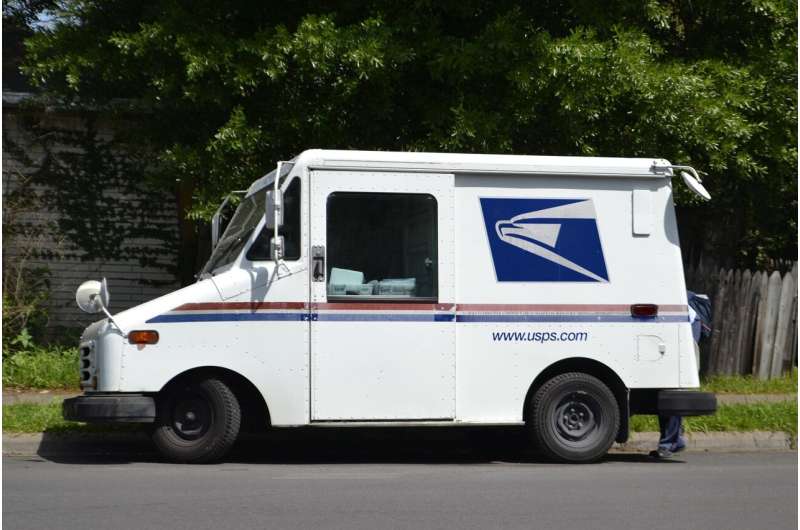Credit: Pixabay/CC0 Public Domain
The U.S. Postal Service is expected in coming days to reaffirm its plan to pay Oshkosh Corp. as much as $6 billion over 10 years to replace an aging fleet of red-white-and blue delivery vans with mostly gasoline-powered models instead of climate-friendly electric vehicles.
The service insists it's the cheapest alternative. But its analysis is based on assumptions that critics and even other government agencies say are unrealistic, such as gasoline at $2.19 a gallon and charging stations that cost roughly $20,000 per facility. And those assumptions will form the bulls-eye of expected legal challenges that could stop Oshkosh's assembly lines before they even start.
"The USPS is running some risk," said Ted Boling, a partner at the law firm Perkins Coie who previously was associate director of the White House Council on Environmental Quality.
The Courts or Congress could force a do-over.
The contract represents a snub of President Joe Biden's executive order for the government to favor emissions-free trucks and cars. The 165,000 delivery vans the USPS could order amount to roughly a quarter of the 645,000 vehicles operated by the federal government, including the military.
It also runs contrary to efforts by private delivery services such as those run by Amazon.com Inc., Walmart Inc. and FedEx Corp. to electrify their fleets as a way to cut costs and slash emissions.
"You have all these other folks moving in a different direction," said Corey Cantor, an electric vehicle associate with BloombergNEF. "USPS is the one that's out of step."
The terms of the Postal Service's February 2021 decision to award the mega-contract to Oshkosh call for potentially 90% of the vehicles to be powered by carbon-belching gasoline engines. They won't even be much more fuel efficient: The service says the new trucks will average 8.6 miles per gallon of gasoline, versus 8.2 for the current fleet.
USPS waited until after it signed the contract to conduct a legally required analysis of the environmental consequences. It says the review proves the original purchase plan is "the most achievable" given its strained finances because gasoline-powered trucks are "significantly less expensive" and can run longer routes than battery-electric alternatives.
Environmental groups say the Postal Service is justifying its decision based on a flawed analysis that downplayed the benefits and overestimated the costs of going electric. Those choices—and the rebuttals by other government agencies—will provide fodder to anticipated legal challenges from environmental groups that could benefit Workhorse Group Inc. and other electric vehicle makers that lost out on the lucrative contract.
The Biden administration has limited authority over the Postal Service because it is an independent agency, but federal courts have found it is still bound by the National Environmental Policy Act that requires analysis of major policy decisions. And the contract with Oshkosh was contingent on a successful conclusion of the NEPA process.
The Postal Service concluded that going electric would end up costing more overall, factoring in the upfront price as well as the costs of fuel, maintenance, chargers, training, manuals and other expenses over 20 years. The agency said the total cost to own 75,000 of the electric trucks would amount to $11.6 billion compared to $9.3 billion for the same number of gasoline-powered models.
But other studies show the total cost of owning and operating short-haul trucks is close to the same whether the vehicles use electric or combustion engines—even if the electric versions carry a higher sticker price.
The research firm Atlas Public Policy found in a study last year that electrifying the USPS fleet could actually yield $4.3 billion in savings. A separate analysis by the California Air Resources Board found that battery-electric vans similar to those considered by the Postal Service could save almost $5,000 over each vehicle's life.
Moreover, the Environmental Protection Agency points out that the cost of batteries, the most expensive component of an electric vehicle, is rapidly falling.
The Postal Service underpinned its analysis with an assumption of gasoline prices at $2.19 per gallon, based on the nationwide average on Oct. 12, 2020. That's well below the $3.48 that most Americans are paying now. And the Energy Department calculated that last October, when gasoline was going for $3.25 a gallon, the electric equivalent was $1.35.
USPS estimated that charging infrastructure would average $18,740 to $20,970 at each of its facilities. The EPA suggested, however, that the equipment could be shared with other government bodies.
The EPA and White House have urged the Postal Service to conduct a new analysis or at least make initial purchases all electric. Postmaster General Louis DeJoy said the agency could buy more electric models if it got more money from Congress.
"These vehicles are going to be on the road for the next several decades and they're going to be in literally every single neighborhood in the country," said Patricio Portillo, a senior advocate at the Natural Resources Defense Council. "It's really critical that we get this purchase decision right."
©2022 Bloomberg L.P.
Distributed by Tribune Content Agency, LLC.























